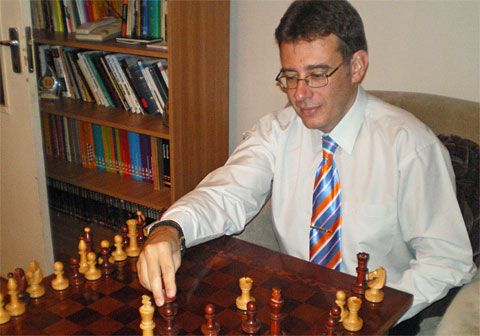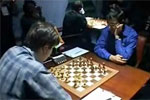
World Championship 2007 Mexico
The World Championship 2007 will take place from September 12 to 30 in the
Sheraton Centro Histórico Hotel in Mexico City. Eight players are qualified
– the tournament will be a double round robin. The prize fund is US $1.3
million.
Commentary by GM Mihail Marin

GM Mihail Marin in his analysis kitchen at home in Romaina
The following express commentary was provided by Romanian Mihail Marin,
who is the author of a number of very popular ChessBase training CDs and articles
for ChessBase Magazine. GM Marin will study the games of the World Championship
tournament in much greater detail and provide the full results of his analysis
in the next issue of ChessBase
Magazine.
Round twelve commentary by GM Mihail Marin
A spectacular round, with big fights and three decisive games. The previous
round's hero, Anand, was the co-author of the only draw. Playing with black
against Svidler, he annihilated White's initiative with relative ease and retained
a slightly more pleasant position.
Morozevich was once again successfull with an original opening experiment,
but only after Grischuk lost his thread before the first time control. Kramnik
produced another impressive Catalan performance, but it seems that Leko missed
his chance for equality when he decided to stick to his material advantage.
Aronian employed a very original, but also risky plan with white. At some
moment, he pushed his g-pawn just too far and Gelfand found effective ways to
take advantage of White's kingside weaknesses.
Svidler,P (2735) - Anand,V (2792) [C88]
WCh Mexico City MEX (12), 27.09.2007 [Mihail Marin]
1.e4 e5 2.Nf3 Nc6 3.Bb5 a6 4.Ba4 Nf6 5.0-0 Be7 6.Re1 b5 7.Bb3 0-0. Given
the tournament situation, Anand chooses the safe (nowadays) Marshall Attack.
A couple of decades ago, this comment would have been pure nonsense. 8.h3
Bb7 9.d3 Re8 10.a4 h6
11.axb5. In Wijk aan Zee earlier this year, the game between the same
players, but with reversed colours, continued with 11.c3.
11...axb5 12.Rxa8
Bxa8 13.c3 Bf8 14.d4 d6. The position is typical for the Zaitsev system.
15.d5
Na5 16.Ba2 c6 17.Na3
Black has the more flexible structure, but White intends to play b4, forcing
...Nb7, when the knight would remain passive for a long time. 17...Qc7! Solving
the problems of coordination by simple tactical means. 18.Qe2. 18.b4
would be answered by 18...Nc4 , for instance 19.Nxc4 bxc4 20.Bxc4 cxd5 21.Bxd5
Nxd5 22.exd5 Qc4 retrieving the pawn with excellent play. 18...cxd5 19.Nxb5
Qd7 20.exd5 Bxd5 21.Bxd5 Nxd5 22.Rd1 Nf6. In the long run, Black's centre
should offer him the better chances, but a draw brings Anand a step closer to
his goal. 1/2-1/2. [Click
to replay]

Click to replay video impressions from round 12 [by Vijay Kumar]
Morozevich,A (2758) - Grischuk,A (2726) [A28]
WCh Mexico City MEX (12), 27.09.2007 [Mihail Marin]
1.c4 Nf6 2.Nc3 e5 3.Nf3 Nc6 4.d3!? Of course. Morozevich is not interested
in long theoretcial disputes after the ever fashionable 4.g3. 4...d5 5.cxd5
Nxd5 6.e4 Nf6
The position is typical for the Boleslavsky Sicilian (1.e4 c5 2.Nf3 Nc6 3.d4 cxd4
4.Nxd4 Nf6 5.Nc3 d6 6.Be2 e5 7.Nb3), but with reversed colours. The system is
considered to offer Black excellent chances in the Sicilian, and the extra tempo
should make the position suitable for ambitious play with White in the English
Opening. It should be sayed, however, that Black could eventually get his tempo
back by playing the active ...Bc5 in just one move (which explains why Grischuk
played ...Nf6 instead of ...Nb6, leaving the b6-square available for the bishop).
7.Be2 Bg4 8.0-0 Bxf3 9.Bxf3 Nd4 10.g3 Bc5 11.Bg2 0-0. Maybe it would have
been worth to spend a tempo on 11...a6!? , maintaining the stability of the bishop
along the important g1-a7 diagonal.
12.Na4 Bb6 13.Be3 Qd6 14.f4 Nd7 15.Kh1
Rad8 16.Rc1
A very complex position has arisen. At first sight, it might look that Black has
a stable domination on dark squares. However, White exerts strong pressure against
the critical d4- and e5- squares and can incresae it with such moves as Bh3 and
Qh5.
16...Nc6?! This voluntary retreat, carried out with the obvious aim
of "winning" the d3-pawn, is in fact a concession, allowing White to
activate his play. More consistent would have been 16...c6 , for instance 17.Nxb6
axb6 18.Qh5 f6 19.Bh3 Nc5 with a stable position for Black, despite White's two
bishops. True, if White feels uncomfortable, he can force a draw already with
20.Bxd4 Qxd4 21.Bf5 g6 22.Bxg6.
17.Nxb6 axb6 18.Rc3 Nc5 19.a3 Nxd3 20.Qc2 Nc5
Practically forced, because of the threat Rd1.
21.Bxc5 bxc5 22.Rxc5
This is probably the position both players have been aiming for. Again, a superficial
look would suggest that Black is doing very fine, because his knight would be
so much stronger than the bishop, if just installed on d4. However, after the
unnecessary retreat on the 16th move, it is not so easy to jump back to the centre,
because of White's increased pressure ove rht ec7- and e5-squares.
22...Rfe8?!
Grischuk wants to carry out his plan in pure form, but he will not be in
time for it. He should probably have played 22...Nd4 anyway, for instance 23.fxe5
Qb6 24.Qc3 c6 and White's extra-pawn might be of little relevance, while Black's
regroupment looks acceptable.
23.Rd5 Qe7 24.Qb3 Suddenly, White has strong
pressure now. Even the apparently passive bishop is very useful, by indirectly
sustaining the d5-rook.
24...exf4 The complicatons initiated by this move
will prove favourable for White.
25.Qxb7 Rxd5 26.exd5 Nd4 27.Rxf4 Qc5 28.Rf1
g6 29.Qa6 Re2 30.d6 cxd6 31.b4 Qc2 32.Qxd6 Nf5 33.Qd8+ Kg7 34.Qd5. Black's
activity is not too threatening. Besides, his own king is vulnerable, too. Grischuk
went down quickly during the remaining moves until the time control.
34...Qb2?!
35.g4! Rd2 36.Qf3 Nd6 37.h3 f5?! 38.Qg3 Qc2? 39.gxf5 Nxf5
40.Rxf5! Rxg2. Grischuk might have relied on this intermediate move,
failing to notice that he will fall under decisive attack. Anyway, 40...Qxf5
would drop the rook to 41.Qc3+. 41.Qe5+ Kh6 42.Qe3+ 1-0. [Click
to replay]
Kramnik,V (2769) - Leko,P (2751) [E06]
WCh Mexico City MEX (12), 27.09.2007 [Mihail Marin]
1.d4 Nf6 2.c4 e6 3.g3 d5 4.Bg2 Be7 5.Nf3 0-0 6.0-0 dxc4 7.Qc2 a6 8.Qxc4
b5 9.Qc2 Bb7 10.Bd2 Be4 11.Qc1 Qc8 12.Bg5 Nbd7
The moment of truth has come. Leko fights agains Kramnik with his own weapons.
Quite risky policy, I must say.
13.Qf4!? Here comes the novelty, sidestepping
most of the theoretical knowledge that has been accumulated in recent years.
13...Bb7.
After a long thought, Leko refrains from 13...c5 , which seems to be a critical
continuation.
14.Rc1. There is something remarkable about White's last
moves. I can't help thinking compairing them with certain patterns of play in
chess problems (mates in 3 or 4, helpmates). White's pieces tend to make full
use of the space left available by their colleagues. 12.Bg5 has made available
a whole new diagonal for the queen and she uses it immediately, making the longest
possible move. This has cleared the c1-square and the king's rook hurries too
ccupy it. I would also notice that the queen and the bishop concentrate their
pressure on the f6-square, while the queen and the rook attack the c7-square.
To my understanding, this is pure harmony, but let us return to the more concrete
world of practical chess.
14...Bd6 15.Qh4 h6 16.Bxf6 Nxf6 17.Nbd2
White has a slight advance in development and has managed to prevent the freeing
move ...c5. However, he has to find a way to coordinate his queen with the other
pieces, in order not to lose... harmony.
17...Re8 18.e4 Nd7 19.Nb3 a5. Up
to this moment,Kramnik had spent around a quarter of an hour, but now he sank
into deep thinking.
20.Nc5. The thematic 20.a4 fails to offer an advantage
after 20...bxa4 21.Rxa4 Bb4 . There are too many pieces along the fourth rank,
preventing the coordination between the a4-rook and the queen.; My first thought
was that the knight jump to c5 should have been prepared with 20.Rc2 a4 21.Nc5
, but maybe Leko's last move was more of a defence against the threat Na5 than
a preliminary step for the further advance of the pawn.; After 20.Rc2 , Kramnik
might have disliked 20...e5.
20...Be7. The capture on c5 would have made
the b7-bishop feel uncomfortable. Leko decides to solve his problems by... winning
material.
21.Qf4 e5 22.Nxe5 Nxe5 23.dxe5 Bg5 24.Qf3 Bxc1 25.Rxc1 Rxe5 26.Qc3
White's compensation for the sacrificed exchange consists of his much more active
placement of pieces. The b7-bishop and the a8-rook cannot be brought into play
too easily. Continuing the discussion about harmony, White's position looks opticaly
perfect from this point of view.
26...f6?! It is hard to say whether Leko
underestimated White's compensation, or, on the contrary, feared that after 26...Re7
27.Nxb7 Qxb7 28.e5 Qa7 29.Bxa8 Qxa8 his position would remain difficult. I believe
that White would have not found it easy to consolidate his advantage of space,
because there is too little material left on board and his position contains some
weaknesses, too.
27.Qb3+ Kh8?! Another uninspired decision. As will be
revealed soon, h7 was a safer square for His Majesty.
28.Qf7! Black is
in big trouble. The immediate threats are Nxb7 or Nd3 followed by Rxc7.
28...Bc6
29.Nd3 Re6. With the king on h7, Black could have resisted with 29...Be8,
when 30.Qf8 would have been without check.
30.Nf4. Continuing the attack
rather than pinning the rook with the trivial 30.Bh3.
30...Rd6 31.Ng6+ Kh7
32.e5!
White wins material now. 32...fxe5 33.Bxc6 Rf6 34.Qd5 Qf5 35.Bxa8 Qxf2+
36.Kh1 Qxb2 37.Qc5 Kxg6 38.Be4+ Kh5 39.Rb1 1-0. [Click
to replay]
Aronian,L (2750) - Gelfand,B (2733) [D43]
WCh Mexico City MEX (12), 27.09.2007 [Mihail Marin]
1.d4 d5 2.c4 c6. By choosing a Slav move order, Gelfand avoids Aronian's
unusual setup from his earlier game against Grischuk. 3.Nf3 Nf6 4.Nc3 e6
5.Bg5 h6 6.Bxf6 Qxf6 7.e3 Nd7 8.Bd3 dxc4. A curious moment. This early
release of the tension in the centre is only apparently a concession. In the
first round game Kramnik-Svidler, Black played 8...g6 , which offered White
the additional possibility of winning space in the centre with 9.e4 dxc4 10.e5!
Qe7 11.Bxc4. 9.Bxc4 g6 10.0-0 [Now, 10.e4 can always be met by 10...e5!
10...Bg7 11.Rc1 0-0
12.Ne4 Qe7 13.Bb3 Rd8 14.Qc2. Aronian has chosen a rarely seen setup, with
his knight in front of the e-pawn, which deprives him of the possibility of winning
space in the centre. White's phylosophy in the current position is to prevent
Black from completing his development or freeing his position with the thematic
...c5 or ...e5, rather than start active operations himself.
14...e5. Black
usually shies away from this move, preferring to jump with his knight to f6 or
b6.
15.Rfe1. A subtle move. White discourages the exchange on d4, which
would leave the black queen vulnerable after exd4.
15...Kh8. Less subtle,
but very strong. Black threatens with the brutal ...f5.
16.g4!? It is hard to give a final evaluation of this exotic move, since
it almost surely made part of Aronian's preparation. It also bears strong similarity
with the advance of the g-pawn from his aforementioned game against Grischuk.
I get the feeling that, having been deprived of the possibility of playing Nbd2!?
in the opening, Aronian "transposed" to the familiar territory with
his last move. Anyway, White's main idea is the same: to ensure some stability
to the knights. However, there is a significant difference compared to the previous
game: Black's kingside structure is more flexible because the g-pawn is on g6
instead of g5. This is clearly to Black's favour, since White's kingside position
remains shaky.
16...Rf8! After the radical weakening of White's kingside,
the rook changes plans. From f8, it defends the f7-pawn, enabling ...Nb6, which
attacks the g4-pawn, while also sustaining an eventual advance of the f-pawn to
f5.
17.g5?! This new advance of the g-pawn will fail to stabilize the
position. Maybe it was time to think about safety with 17.Ng3.
17...f5 18.gxf6
Bxf6 19.Kg2 Bg7
20.h4?! Strategically correct, but, with queens on board, very risky.
20...Nb6
21.dxe5? It seems that after this move White's game cannot be saved anymore.
21.Nxe5 would have been a lesser evil.
21...Bg4. Not a bad move, but 21...Rxf3!
seems to have been decisive, too: 22.Kxf3 Bf5 23.Kg2 The only way to get out of
the nasty pin. 23...Qxh4 24.f4 and now, Black has 24...Nd7 , when White's poor
coordination prevents him from parrying such a simple threat as ...Nxe5, when
Black's attack will take decisive proportions.
22.Ned2 Nd7 23.e6. This
makes it easier for Black, who can win with normal moves. 23.Qxg6 would have been
more demanding. White threatens Bc2, but Black is the first to deliver decisive
blows: 23...Nxe5 24.Nxe5
24...Rxf2+! 25.Kxf2 Qxh4+ 26.Kg1 Bxe5 27.Nf1 Rf8 Threatening ...Qf2+ or ...Rxf1+,
followed by mate. 28.Rc2 Bf3 29.Rg2 Apparently, White has defended, but the next
move shatters the illusion. 29...Be4! White has no adequate way to maintain the
rook defended. For instance, 30.Qg4 loses the queen to 30...Bh2+! 31.Kh1
(31.Nxh2
leads to mate after
31...Qxe1+ 32.Nf1 Rxf1+ 33.Kh2 Rh1#) 31...Qxg4!
23...Ne5 24.Nh2 Qxh4
Around this moment, Gelfand must have felt like in the good old days, when
the King's Indian was his main weapon against 1.d4. 25.f4 Bf5 26.Ne4 Qh3+
27.Kg1 Nf3+ 28.Nxf3 Qxf3 29.Ng5 hxg5 30.Qh2+ Qh5 31.Qxh5+ gxh5 32.e7 Rfe8 33.Rc5
Bg4 34.Rxg5 Rxe7 35.Kg2 Bf6 36.Rg6 Rf8 37.e4 Bf5 38.Rh6+ Kg7 39.Rxh5 Bxe4+ 40.Kh2
Bd5 0-1. [Click to
replay]
All results of the round
| Round 12: Thursday, Sept 27th 2007, 14:00h |
Peter Svidler |
½-½ |
Viswanathan Anand |
Alexander Morozevich |
1-0 |
Alexander Grischuk |
Vladimir Kramnik |
1-0 |
Peter Leko |
Levon Aronian |
0-1 |
Boris Gelfand |
| |
Current standings

Links







